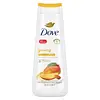What's inside
What's inside
 Key Ingredients
Key Ingredients

No key ingredients
 Benefits
Benefits

 Concerns
Concerns

 Ingredients Side-by-side
Ingredients Side-by-side

Water
Skin ConditioningSodium Hydroxypropyl Starch Phosphate
AbrasiveLauric Acid
CleansingSodium Lauroyl Isethionate
CleansingSodium Methyl Lauroyl Taurate
CleansingCocamidopropyl Betaine
CleansingHydrogenated Soybean Oil
EmollientGlycine Soja Oil
EmollientSodium Chloride
MaskingParfum
MaskingGlycerin
HumectantStearic Acid
CleansingPalmitic Acid
EmollientHydrogenated Vegetable Glycerides
EmollientHydroxystearic Acid
CleansingGlyceryl Stearate
EmollientMangifera Indica Seed Butter
Skin ConditioningPrunus Amygdalus Dulcis Oil
Skin ConditioningHydrogenated Vegetable Oil
EmollientSodium Benzoate
MaskingGuar Hydroxypropyltrimonium Chloride
Skin ConditioningCapryloyl Glycine
CleansingUndecylenoyl Glycine
CleansingCitric Acid
BufferingSodium Gluconate
Skin ConditioningLimonene
PerfumingLinalool
PerfumingCI 17200
Cosmetic ColorantCI 19140
Cosmetic ColorantWater, Sodium Hydroxypropyl Starch Phosphate, Lauric Acid, Sodium Lauroyl Isethionate, Sodium Methyl Lauroyl Taurate, Cocamidopropyl Betaine, Hydrogenated Soybean Oil, Glycine Soja Oil, Sodium Chloride, Parfum, Glycerin, Stearic Acid, Palmitic Acid, Hydrogenated Vegetable Glycerides, Hydroxystearic Acid, Glyceryl Stearate, Mangifera Indica Seed Butter, Prunus Amygdalus Dulcis Oil, Hydrogenated Vegetable Oil, Sodium Benzoate, Guar Hydroxypropyltrimonium Chloride, Capryloyl Glycine, Undecylenoyl Glycine, Citric Acid, Sodium Gluconate, Limonene, Linalool, CI 17200, CI 19140
Water
Skin ConditioningMilk
Skin ConditioningGoat Milk
Skin ConditioningGlyceryl Stearate
EmollientPEG-100 Stearate
Parfum
MaskingCetearyl Alcohol
EmollientEthyl Macadamiate
Skin ConditioningC13-15 Alkane
SolventCitrus Limon Juice
Skin ConditioningPropylene Glycol
HumectantOlea Europaea Fruit Oil
MaskingBehentrimonium Chloride
PreservativeLitsea Cubeba Fruit Oil
MaskingDipteryx Odorata Seed Extract
MaskingEthyl Vanillate
PerfumingCetrimonium Chloride
AntimicrobialPhenoxyethanol
PreservativeBenzyl Alcohol
PerfumingAnise Alcohol
PerfumingBenzyl Benzoate
AntimicrobialBenzyl Cinnamate
PerfumingCinnamal
PerfumingCitral
PerfumingCoumarin
PerfumingGeraniol
PerfumingLimonene
PerfumingLinalool
PerfumingWater, Milk, Goat Milk, Glyceryl Stearate, PEG-100 Stearate, Parfum, Cetearyl Alcohol, Ethyl Macadamiate, C13-15 Alkane, Citrus Limon Juice, Propylene Glycol, Olea Europaea Fruit Oil, Behentrimonium Chloride, Litsea Cubeba Fruit Oil, Dipteryx Odorata Seed Extract, Ethyl Vanillate, Cetrimonium Chloride, Phenoxyethanol, Benzyl Alcohol, Anise Alcohol, Benzyl Benzoate, Benzyl Cinnamate, Cinnamal, Citral, Coumarin, Geraniol, Limonene, Linalool
 Reviews
Reviews

Ingredients Explained
These ingredients are found in both products.
Ingredients higher up in an ingredient list are typically present in a larger amount.
Glyceryl Stearate is a mix of glycerin and stearic acid.
It is used to stabilize the mixing of water and oil ingredients. By preventing these ingredients from separating, it can help elongate shelf life. It can also help thicken the product's texture.
As an emollient, it helps soften skin and supports barrier-replenishing ingredients.
In cosmetics, Glyceryl Stearate is often made from vegetable oils or synthetically produced.
This ingredient may not be fungal-acne safe
Fun fact: The human body also creates Glyceryl Stearate naturally.
Learn more about Glyceryl StearateLimonene is a fragrance that adds scent and taste to a formulation.
It's found in the peel oil of citrus fruits and other plants such as lavender and eucalyptus. The scent of limonene is generally described as "sweet citrus".
Limonene acts as an antioxidant, meaning it helps neutralize free radicals.
When exposed to air, oxidized limonene may sensitize the skin. Because of this, limonene is often avoided by people with sensitive skin.
The term 'fragrance' is not regulated in many countries. In many cases, it is up to the brand to define this term. For instance, many brands choose to label themselves as "fragrance-free" because they are not using synthetic fragrances. However, their products may still contain ingredients such as essential oils that are considered a fragrance.
Learn more about LimoneneLinalool is a fragrance and helps add scent to products. It's derived from common plants such as cinnamon, mint, citrus, and lavender.
Like Limonene, this ingredient oxidizes when exposed to air. Oxidized linalool can cause allergies and skin sensitivity.
This ingredient has a scent that is floral, spicy tropical, and citrus-like.
Learn more about LinaloolParfum is a catch-all term for an ingredient or more that is used to give a scent to products.
Also called "fragrance", this ingredient can be a blend of hundreds of chemicals or plant oils. This means every product with "fragrance" or "parfum" in the ingredients list is a different mixture.
For instance, Habanolide is a proprietary trade name for a specific aroma chemical. When used as a fragrance ingredient in cosmetics, most aroma chemicals fall under the broad labeling category of “FRAGRANCE” or “PARFUM” according to EU and US regulations.
The term 'parfum' or 'fragrance' is not regulated in many countries. In many cases, it is up to the brand to define this term.
For instance, many brands choose to label themselves as "fragrance-free" because they are not using synthetic fragrances. However, their products may still contain ingredients such as essential oils that are considered a fragrance by INCI standards.
One example is Calendula flower extract. Calendula is an essential oil that still imparts a scent or 'fragrance'.
Depending on the blend, the ingredients in the mixture can cause allergies and sensitivities on the skin. Some ingredients that are known EU allergens include linalool and citronellol.
Parfum can also be used to mask or cover an unpleasant scent.
The bottom line is: not all fragrances/parfum/ingredients are created equally. If you are worried about fragrances, we recommend taking a closer look at an ingredient. And of course, we always recommend speaking with a professional.
Learn more about ParfumWater. It's the most common cosmetic ingredient of all. You'll usually see it at the top of ingredient lists, meaning that it makes up the largest part of the product.
So why is it so popular? Water most often acts as a solvent - this means that it helps dissolve other ingredients into the formulation.
You'll also recognize water as that liquid we all need to stay alive. If you see this, drink a glass of water. Stay hydrated!
Learn more about Water